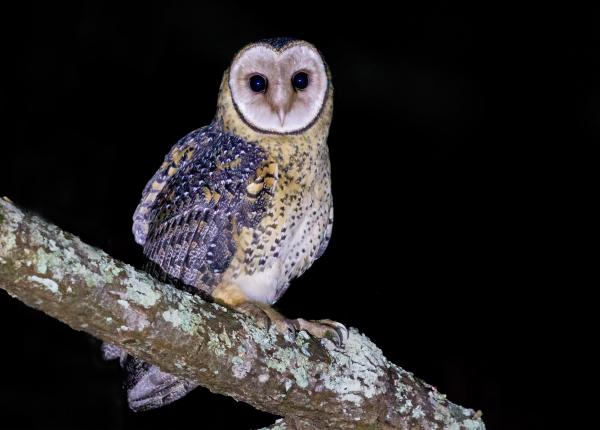Did You Know?
- There are nine recognized subspecies of the Australian Masked-owl
- Females often hunt prey that is a lot larger than what the males hunt. This makes sense since the females can be much bigger than the males.
- Like other raptors, these owls regurgitate pellets, which are soft clumps of undigestible bits of their prey, such as bones, claws, and fur. At one Australian Masked-owl nest site, biologists found around 20 kilograms of pellet material that had accumulated in and around the nest after many years of use!
How The Peregrine Fund is Helping
Though The Peregrine Fund does not work directly with Australian Masked-owls, our efforts in scientific research, habitat conservation, education, and community development help conserve birds of prey around the world. We also supply literature to researchers from our avian research library, which helps scientists around the world gather and share important information on raptor conservation. Our support of the Global Raptor Information Network gives raptor researchers tools to more efficiently conduct their own studies while contributing to a global program. It also provides citizen scientists a way to participate in raptor science and conservation.
Where it Lives
This species is found in Australasia, namely Australia, Indonesia, and Papua New Guinea. It makes its home in forests that contain sparse ground cover and tall trees. It also spends time in farmland, riparian areas, pine plantations, and even along the edges of mangroves and swamps.
What it Does
Like most owl species, the Australian Masked-owl is nocturnal. It can be quite a vocal species, and has a large repertoire of calls. Its vocalizations have been described using such words as "screams, cackles, hisses, and squeals!"
Why it Needs our Help
This owl is categorized globally as a species of Least Concern. However, in Tasmania it is now considered Endangered. In some parts of its range, its population is relatively stable, but it is declining in others. Human persecution and a reduction in prey species are some of the threats this owl faces.
What it Eats
This species will dine on a plethora of different prey species, both big and small. The smallest prey it takes includes insects, such as beetles and moths. It will also feed on mice and rats, rabbits, possums, bandicoots, and gliders. But its menu doesn't stop there. It is known to take birds too - including kookaburras, magpies, sparrows, and even domestic fowl. While the Australian Masked-owl does sometimes capture prey in trees, it captures most of its meals on the ground. It might fly over in search of prey, or wait patiently on a perch. Some arboreal species taken, but most prey captured on ground, by hunting both on wing and from perches; after dusk, changes from low hunting flights over open ground to perch-hunting.
Nests, Eggs, and Young
Like most owl species, the Australian Masked-owl doesn't build its own nest (though it might rarely dig a small depression in the substrate or add a few sprigs). Instead, it lays its eggs in natural cavities or holes in trees or on cliff ledges. Pairs will often use the same nest site for many years. The female will lay between 2-4 eggs, which must be incubated for around 5-6 weeks. When the owlets hatch they are covered in white down. Both parents work hard to care for and feed their young. In one study, observers documented that the male and female together brought an average of 1·2 prey items every hour to the nest! That is a lot of food! After 10–12 weeks, the young owls will be ready to fledge, or fly from the nest for the first time. Even after they have left the nest, the young will remain with their parents for a number of weeks as they learn to hunt and otherwise survive on their own.
Australian Masked-owl and the World Center for Birds of Prey
The World Center for Birds of Prey offers fun ways to learn about raptors. Interactive activities, tours, interesting videos and a children's room with activities from coloring sheets to quizzes to costumes await you. At our visitor center, you can see live owls up close - such as a Verreaux's Eagle-owl or a Western Screech-owl, and learn about the wonderful and interesting adaptations they have in order to survive in their respective habitats. There is also a touch table with owl feathers and other natural objects available for exploration. Though far from Australian Masked-owl habitat, if you take a stroll along a short nature trail around the center, you may come across other owl species including Barn Owls or even a Northern Saw-whet Owl perched in the trees.
References:
BirdLife International. 2018. Tyto novaehollandiae. The IUCN Red List of Threatened Species 2018: e.T62172196A132190206. https://dx.doi.org/10.2305/IUCN.UK.2018-2.RLTS.T62172196A132190206.en. Accessed on 19 August 2022.
Bruce, M.D. and J. S. Marks (2020). Australian Masked-Owl (Tyto novaehollandiae), version 1.0. In Birds of the World (S. M. Billerman, B. K. Keeney, P. G. Rodewald, and T. S. Schulenberg, Editors). Cornell Lab of Ornithology, Ithaca, NY, USA. https://doi.org/10.2173/bow.aumowl1.01










